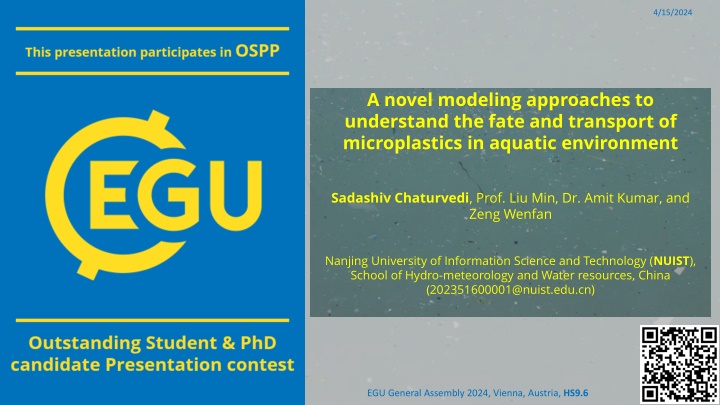
Novel Approaches for Understanding Microplastic Fate and Transport in Aquatic Environments
Researchers at Nanjing University of Information Science and Technology are exploring novel modeling approaches to comprehend the distribution and movement of microplastics in aquatic ecosystems. Microplastics, measuring less than 5mm, have become ubiquitous, posing threats to marine life and human health. Challenges include limited datasets, methodological gaps, and the need for hybrid models to integrate diverse environmental factors. By coupling advanced simulation tools like CaMPSim-3D and DuMuX, researchers aim to better model the behavior of microplastics. Future prospects involve continued modeling refinement, technological advancements in biodegradation, and the shift towards sustainable alternatives to plastic.
Download Presentation

Please find below an Image/Link to download the presentation.
The content on the website is provided AS IS for your information and personal use only. It may not be sold, licensed, or shared on other websites without obtaining consent from the author. If you encounter any issues during the download, it is possible that the publisher has removed the file from their server.
You are allowed to download the files provided on this website for personal or commercial use, subject to the condition that they are used lawfully. All files are the property of their respective owners.
The content on the website is provided AS IS for your information and personal use only. It may not be sold, licensed, or shared on other websites without obtaining consent from the author.
E N D
Presentation Transcript
4/15/2024 A novel modeling approaches to understand the fate and transport of microplastics in aquatic environment Sadashiv Chaturvedi, Prof. Liu Min, Dr. Amit Kumar, and Zeng Wenfan Nanjing University of Information Science and Technology (NUIST), School of Hydro-meteorology and Water resources, China (202351600001@nuist.edu.cn) EGU General Assembly 2024, Vienna, Austria, HS9.6
Microplastics Less than 5mm in size Every corner of the planet, from the deepest ocean trenches to remote polar regions Disrupting food webs and endangering aquatic life Transport harmful pathogens and invasive species, worsening ecological imbalances Detected microplastic contamination in drinking water, seafood, and salt Adverse health outcomes inflammation, oxidative stress, transfer of chemical pollutants; research is going on.. 4/15/2024 EGU General Assembly 2024, Vienna, Austria, HS9.6
Current Challenges in Modeling Microplastics Limited Availability of Datasets Methodological Inadequacies Focus on Field Monitoring Rather Than Modeling Incorporating Biological Interactions Scaling from Laboratory to Field Conditions Assessing Long-Term Impacts 4/15/2024 EGU General Assembly 2024, Vienna, Austria, HS9.6
Need for Hybrid Models Integration of Multiple Models Hybrid Modeling Frameworks Coupled Environmental Models Data Assimilation Techniques Interdisciplinary Collaboration Standardization and Benchmarking 4/15/2024 EGU General Assembly 2024, Vienna, Austria, HS9.6
Coupling CaMPSim-3D and DuMuX CaMPSim-3D uses a Lagrangian approach to track individual microplastic particles in 3D space. It can consider spatially and temporally varying diffusivity of microplastics. DuMuX includes pre-implemented models for a wide range of applications, including multi-phase multi-component flow, reactive transport, solid mechanics, and shallow water equations. Possible to incorporate additional physical processes, such as hydrodynamics, sediment transport, and biogeochemical interactions, to more accurately model the fate and behavior of microplastics in aquatic systems. 4/15/2024 EGU General Assembly 2024, Vienna, Austria, HS9.6
Mitigation Strategies and Future Prospect Data Data Data More hit and trails in modeling and large scale integration Technical development in biological degradation Replacing plastic with more sustainable products such as Hemp fiber bag and other sustainable materials. Focusing more on NBS. https://www.tno.nl/en/sustainable/circular-plastics/microplastics- unknown-risks/reducing-microplastics/ 4/15/2024 EGU General Assembly 2024, Vienna, Austria, HS9.6
4/15/2024 Reference https://www.tno.nl/en/sustainable/circular-plastics/microplastics-unknown-risks/reducing-microplastics/ https://www.statista.com/topics/5401/global-plastic- waste/#:~:text=Plastic%20waste%20generation%20and%20treatment,staggering%20one%20billion%20metric%20tons. https://www.unep.org/interactives/beat-plastic-pollution/ https://www.oecd.org/environment/plastic-pollution-is-growing-relentlessly-as-waste-management-and-recycling-fall-short.htm Pilechi A., Abdolmajid M., Murphy E., A numerical framework for modeling fate and transport of microplastics in inland and coastal waters, Marine Pollution Bulletin, Volume 184,2022, https://doi.org/10.1016/j.marpolbul.2022.114119. Timo K., Dennis G., Kilian W., et al., DuMux 3 an open-source simulator for solving flow and transport problems in porous media with a focus on model coupling, Computers & Mathematics with Applications, Volume 81, 2021, https://doi.org/10.1016/j.camwa.2020.02.012. Jingyi L., Huihui L., Paul C.J., 2018, Microplastics in freshwater systems: A review on occurrence, environmental effects, and methods for microplastics detection, Water Research, https://doi.org/10.1016/j.watres.2017.12.056 Kumar A., Krishnan G., Microplastic Pollutants in Aquatic Ecosystems: Present and Future Challenges, 2023, Water 16(102) https://doi.org/10.3390/w16010102 Kumar A., Upadhyay P., Prajapati S.K, 2022, Impact of microplastics on riverine greenhouse gas emissions: a view point, Environmental Science and Pollution Research, https://doi.org/10.1007/s11356-022-23929-2 EGU General Assembly 2024, Vienna, Austria, HS9.6





















